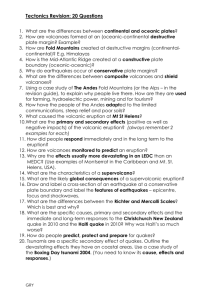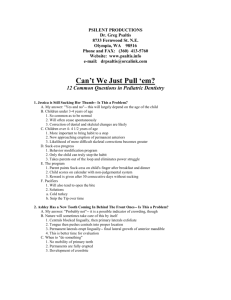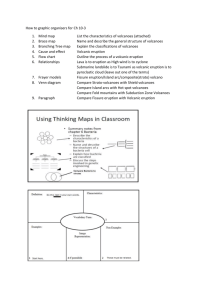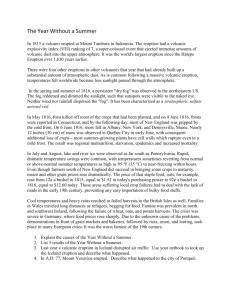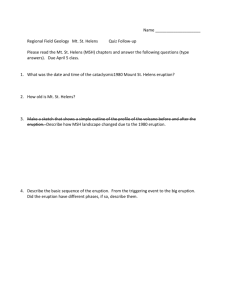There is a predictable pattern to the eruption of teeth
advertisement
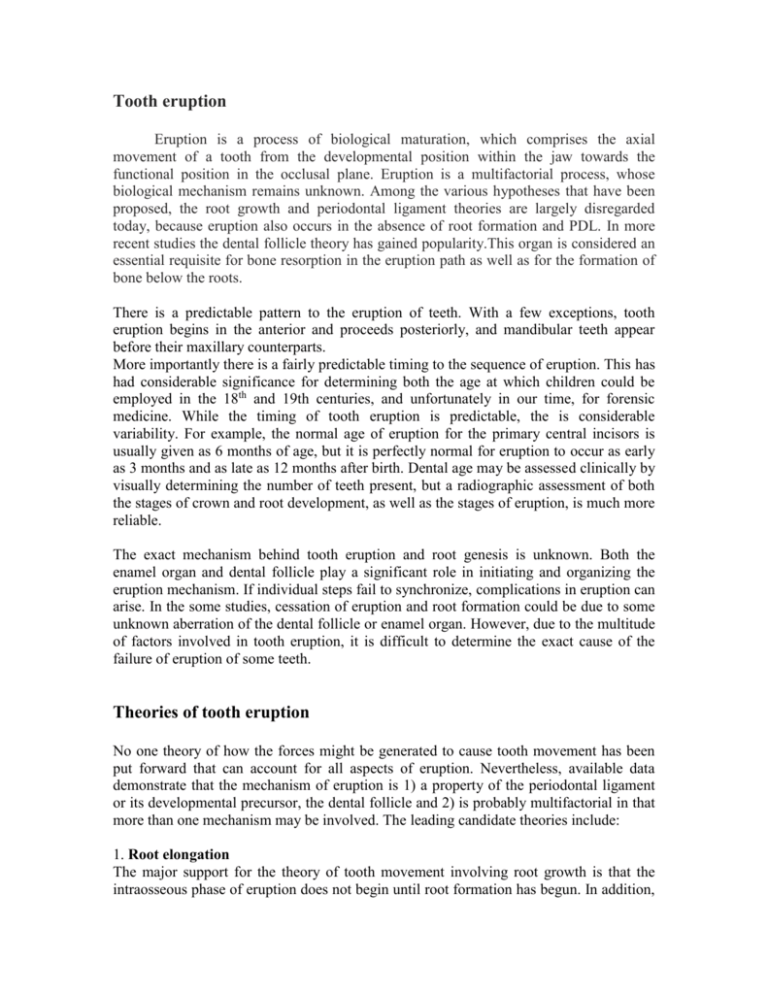
Tooth eruption Eruption is a process of biological maturation, which comprises the axial movement of a tooth from the developmental position within the jaw towards the functional position in the occlusal plane. Eruption is a multifactorial process, whose biological mechanism remains unknown. Among the various hypotheses that have been proposed, the root growth and periodontal ligament theories are largely disregarded today, because eruption also occurs in the absence of root formation and PDL. In more recent studies the dental follicle theory has gained popularity.This organ is considered an essential requisite for bone resorption in the eruption path as well as for the formation of bone below the roots. There is a predictable pattern to the eruption of teeth. With a few exceptions, tooth eruption begins in the anterior and proceeds posteriorly, and mandibular teeth appear before their maxillary counterparts. More importantly there is a fairly predictable timing to the sequence of eruption. This has had considerable significance for determining both the age at which children could be employed in the 18th and 19th centuries, and unfortunately in our time, for forensic medicine. While the timing of tooth eruption is predictable, the is considerable variability. For example, the normal age of eruption for the primary central incisors is usually given as 6 months of age, but it is perfectly normal for eruption to occur as early as 3 months and as late as 12 months after birth. Dental age may be assessed clinically by visually determining the number of teeth present, but a radiographic assessment of both the stages of crown and root development, as well as the stages of eruption, is much more reliable. The exact mechanism behind tooth eruption and root genesis is unknown. Both the enamel organ and dental follicle play a significant role in initiating and organizing the eruption mechanism. If individual steps fail to synchronize, complications in eruption can arise. In the some studies, cessation of eruption and root formation could be due to some unknown aberration of the dental follicle or enamel organ. However, due to the multitude of factors involved in tooth eruption, it is difficult to determine the exact cause of the failure of eruption of some teeth. Theories of tooth eruption No one theory of how the forces might be generated to cause tooth movement has been put forward that can account for all aspects of eruption. Nevertheless, available data demonstrate that the mechanism of eruption is 1) a property of the periodontal ligament or its developmental precursor, the dental follicle and 2) is probably multifactorial in that more than one mechanism may be involved. The leading candidate theories include: 1. Root elongation The major support for the theory of tooth movement involving root growth is that the intraosseous phase of eruption does not begin until root formation has begun. In addition, the root is only 2/3 formed at the time of emergence into the oral cavity. However, rootless teeth do erupt and the length of the eruption pathway taken by some teeth is longer than the root itself. This theory also requires that the bone at the base of the alveolar crypt be more stable (resistant to pressure resorption) that the overlying bone or primary tooth. However, once the eruption pathway has been formed, the resistance to movement is presumably reduced and root growth may play a role. 2. Alveolar bone remodeling The remodeling of alveolar bone (resorption 'above' and apposition 'below') has received considerable attention. The cells of dental follicle and the reduced enamel epithelium interact to recruit monocytes that differentiate into osteoclasts. These osteoclasts then function to form the eruption pathway. Several lines of evidence support this primary role of the dental follicle in tooth eruption. First, artificial teeth will erupt if placed within a dental follicle. Second, damage to the dental follicle will arrest eruption. Finally, experimental animals in which osteoclast differentiation or function is defective exhibit delayed eruption. In contrast, little data is available to demonstrate how the compensatory apposition of bone at the base of the crypt may be regulated. For permanent anterioir teeth, the role of the dental follicle may be to simply widen a pre-existing eruption pathway. Unlike all the primary teeth and all the other permanent teeth, the developing toothbuds for the incisors maintain their connection to the oral mucosa via a band of connective tissue (gubernacular cord) that connects of the dental follicle and the lamina propria via the gubernacular canal. 3. Periodontal ligament formation and renewal The third major theory of tooth eruption involves the periodontal ligament, and two separate mechanisms have been proposed. The first is dependent on the constant turnover (remodeling) of collagen fibers in the ligament. During maturation, collagen fibers 'shrink' in length by about 10%. Because of the orientation of these oblique collagen fibers, the vector of force generated in aggregate is directed occlusally. The second mechanism involves a small, but measurable, contractile force that can be generated by fibroblasts. Fibroblasts are the most numerous cell type in the periodontal ligament, and they can "attach" to collagen type I fibers via fibronectin and integrins. The difficulty with the periodontal ligament theory is that the periodontal ligament does not become highly organized until after the tooth begins to come into functional occlusion. Therefore, the periodontal ligament theory is unlikely to explain either the intraosseous or mucosal phases of eruption. 4. Periodontal ligament hydrostatic pressure One final theory of tooth eruption has been proposed, which involves periodontal/tissue vascular pressure. This theory requires that eruptive movements are maintained by pressure differentials along the periodontal ligament space, and that periodontal tissue pressures are high. Support for this mechanism includes 1) the predictable effects of vasoactive drugs on eruption behavior, 2) the distribution of fenestrations in alveolar bone proper (greater number at the base) and 3) changes in the number of fenestrations during different phases of eruption. Molecular regulation Relatively little is known about the molecular regulation of tooth renewal, i.e. shedding of the deciduous teeth and development and eruption of the secondary teeth. There appears to exist a regulatory relationship between the development of the primary teeth and the successor , and it may be possible that both activating and inhibitory effects are involved. The localization of DF-95 to reduced enamel epithelium (REE) provides biochemical evidence of the REE involvement and initiation of eruption. The activation of proteases in the enamel organ after crown formation is thought to cause DF-95 fragmentation and release of metalloproteinases by the dental follicle to initiate eruption. Growth factors such as TGF-B, EGF, Interleukin-alpha-1, and CSF-1 have been demonstrated to act as molecular regulators of eruption. The timing of the cascade of biochemical processes that trigger the initiation of root genesis in congruence with the rate of eruption is not known. Molecular studies have revealed that the instructive and permissive tissue interactions during mouse tooth development are mainly mediated by growth factor signaling . Development from initiation to eruption is governed by a sequential and reciprocal signaling process rather than simple one-way messages. The signaling involves all major signaling pathways, including TGF, FGF, Shh and Wnt as well as Eda, Notch, and EGF signaling, and studies with mouse mutants have shown that they are needed simultaneously during critical stages of development. Expression of signals is often redundant: several FGFs are expressed in the initiation stage epithelium, in the enamel knot and in the dental mesenchyme and they signal to receptors expressed differentially by mesenchymal and epithelial cells . Similar co-expressions are evident for BMP and Wnt signals. Nerve growth factor (NGF) is an important neurotrophin (NT) for the development, differentiation, function, and survival of neurons. Based on detection of receptors for NGF it has been proposed that NGF also has an effect on many non-neural tissues. Different receptors for NGF have been identified in recent year. Nerve growth factor receptor (NGFR) expression has been investigated in relation to the developing tooth bud. the locations of NGF and NGFR have been described in primary tooth buds for different developmental stages in rodents , and in sections of pre-natal human tooth buds. Intraosseous tooth eruption is not possible without formation of an eruption path. The fact that bone resorption and bone formation are polarized around erupting teeth and that these events depend upon the adjacent part of the dental follicle strongly indicate that tooth eruption is regulated by the dental follicle. The relationship between NGFR expression in the dental follicle and tooth eruption is unknown. Tooth eruption is a precisely timed, complex process, which requires localized bone resorption to form an eruption pathway and a functioning dental follicle to regulate local bone metabolism . Colony-stimulating factor (CSF)-1 is considered to play a role in the complex process of tooth eruption. It has been proposed that CSF-1 enhances local alveolar bone resorption by increasing the number of mononuclear cells in the dental follicle and osteoclasts on adjacent alveolar bone surfaces. Dental follicle cells transcribe and translate CSF-1 and express receptors for CSF-1. The peak gene expression of CSF-1 in the follicle of the rat lower first molar, is at day 3 postnatally, coincidental with the timing for the maximum influx of monocytes into the follicle The toothless (tl/tl) rat is an osteopetrotic animal in which osteoclast, macrophage, and mononuclear cell numbers are reduced. In this osteopetrotic animal, teeth form but fail to erupt, and remain embedded within their bony crypts. The bone defect in this mutation is not cured by bone marrow transplantation but is improved following treatment with CSF-1. CSF-1 affects the proliferation, differentiation, and survival of mononuclear phagocyte lineage cells and promotes the formation of osteoclasts from hematopoietic stem cells. Treatment of tl/tl mutants with CSF-1 increases osteoclasts, macrophages, and bone resorption and permits tooth eruption. Cellular regulation Osteoclasts form through the differentiation of the hematopoietic precursors in the colony-forming unit granulocyte/macrophages line (CFU-GM). These monocytemacrophage precursors are present in bone marrow as well as in circulating blood. Mature and active osteoclasts can be found on the endosteal surfaces in Haversian canals and on the periosteal surface beneath the periosteum, but are rarely found at other locations within bone. The receptor activator of nuclear factor-kappa ligand (RANKL) is now thought to be the primary molecule responsible for differentiation and function of osteoclasts.This ligand, associated with the Tumor Necrosis Factor (TNF) family, is expressed on the plasma membranes of immature osteoblasts as well as on the surface of stromal cells in soluble and secreted forms. Binding with its receptor, receptor activator of nuclear factor (RANK), leads to preosteoclast differentiation and stimulates their bone resoptive capacity. Osteoprotegrin (OPG), also a member of the TNF family, is a decoy receptor of RANKL and is also produced by osteoblastic cells. OPG competes for the binding of RANKL, and limits the docking of the RANKL with RANK, decreasing the initiation of preosteoclast differentiation and activation. The OPG/RANKL/RANK system has been recognized as the final mediator of osteoclastogenesis and the control mechanism for bone turnover. The OPG to RANKL ratio is often used to indicate if a particular sample is in the resorption or deposition phase. Numerous hormones, cytokines, molecules, and biologic conditions affect the expression of the members of the OPG/RANKL/RANK system. One central component in osteoclast regulation is Tumor Necrosis Factor α (TNF- α). Many of the other factors involved in osteoclastogenesis either increase or decrease TNF-α itself, its receptor, or the induction factor, Nuclear Factor Kappa Beta (NF-kβ). TNF- α and Interluekin 1βeta (IL-1β) have been found to decrease OPG availability to bind RANK through the production of osteoprotegrin ligand. The secondary effect is increased RANK/RANKL binding and subsequent osteoclasts differentiation and activation. Parathyroid hormone (PTH), Vitamin D3, Protein Kinase C (PKC), Protein Kinase A (PKA), Prostaglandin-2 (PGE-2), low oxygen tension, and nitric oxide accumulation all lead to the stimulation of resident stem cells and uni-nucleated preosteoclasts via the upregulation of RANK and RANKL. The biochemical processes involved in the control of tooth eruption are well known. During eruption, cells, proteins and enzymes change in the dental follicle and several growth factors and proteins accelerate or retard eruption rate. Genetic regulation The relationship between rate of tooth eruption and variation in life-history traits and environmental factors in mammals is not well understood. In addition to size, it is expected that eruption is delayed: (1) by generally low body condition, (2) orin areas with mineral deficiencies. (1) Low body condition (i.e. a residual effect of weight after controlling for height; delayed eruption of permanent teeth in humans. However, the effect of body condition was not large and it is assumed that most of the variation in human dentition is explained by genetic variance among populations. In ungulates, only two studies have investigated the relationship between tooth development and somatic growth, but neither of them have separated the effects of body size and body weight. found that the number of erupted incisors increased with body weight in mule deer this provide graphical evidence that individual fallow deer Dama dama with shortmandible and lowbodyweight erupt their first molar later than larger conspecifics. No studies of ungulates have investigated variation among different populations. (2) Calcium, in addition to phosphorus, is a limiting element in the formation of bone (Bazely, 1989) and teeth. Calcium deficiency in forage was found to cause dental disease in pet rabbits Oryctolagus cuniculus .Tooth eruption was delayed in six weaning sheep Ovis aries fed on cereal roughages poor in calcium, compared to five sheep where ground limestone was added to the diet. No study has explored whether calcium is limiting for tooth development in natural populations of mammals. A study gives report on how variation in the tooth eruption of 2241 yearling red deer Cervus elaphus was related to phenotypic ( jawbone size, body weight and body condition) and environmental variables (bedrock calcium, local density and distance from the coast). The prediction that eruption is earlier in larger and fatter deer was tested. The density of local deer and their distance from the coast are known to correlate, respectively, negatively and positively with red deer body weight . Later eruption of permanent teeth with increasing deer density, and earlier eruption with increasing distance from the coast was therefore expected, but no residual effect after body weight was also entered in the model if the effect of density and distance from the coast operated only through body weight. Lastly, earlier eruption in areas with calcium rich bedrock was predicted. Cellular,Molecular and Genetic determination of Tooth Eruption Prepeared by Bushra Habeeb Ahmad



